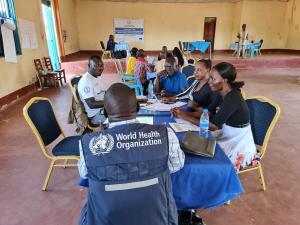South Sudan’s Central Equatoria State strengthens disasters and emergency preparedness and response capabilities
In a world where emergencies and disasters can strike at any moment and anywhere, the importance of proactive preparation cannot be overstated. Central Equatoria State in South Sudan is pioneering a groundbreaking initiative to bolster its resilience against potential hazards, through the development of hazard-specific contingency plans at the county level, the State is taking proactive steps to mitigate the impact of emergencies and disasters on public health and safety.
“The County contingency plans anticipate hazards in locations like Yei River County and ensure a fast and efficient response using hazard-specific plans, potential response scales, scenarios and a multi-hazard core response mechanism,” said Ms Agnes Agnes Nyoka, Primary Health Care Supervisor, Yei River County.
Central Equatoria State faces a diverse scale of threats ranging from armed conflict to infectious diseases and environmental challenges. Recognizing the need for tailored responses to these hazards, the State conducted its first sub-national risk assessment and profiling of hazards in October 2023. The findings highlighted a spectrum of risks, including malaria, Ebola Virus Disease (EVD), and road traffic accidents, among others, each presenting varying degrees of danger to the state's population.
The State embarked on a comprehensive approach to preparedness by developing hazard-specific contingency plans at the county level. Kajo-keji, Morobo, and Yei River Counties were selected for this initiative due to their unique geographic characteristics and susceptibility to specific hazards.
The objectives of the hazard-specific contingency plans include anticipating potential threats, and vulnerabilities and minimizing their impact on public health through proactive measures; identifying specific needs associated with each hazard and outlining mitigation actions tailored to address them effectively; developing detailed plans for the implementation of mitigation actions, including resource allocation and time estimates; identify and mobilize the necessary resources, including personnel, equipment, logistics capacities, and supplies, to support response efforts and continuously monitor progress in plan implementation to assess effectiveness and adapt strategies as needed.
By adhering to these objectives, the State aims to not only enhance its capacity to respond to emergencies and disasters but also to build a culture of resilience within its communities. Through proactive planning, monitoring and coordination, the State seeks to minimize illness, death and disability caused by emergencies and disasters, ultimately safeguarding the well-being of its population.
"South Sudan has taken proactive steps to address public health challenges. As a result, the national and subnational levels have implemented decentralized risk profiling and emergency plans while establishing Task Forces and multidisciplinary Rapid Response Teams at the State and County levels," said Mr Yona Kenyi, Surveillance Officer, Central Equatoria State. "Our approach prioritizes community involvement in identifying potential hazards and ensures that county-level, hazard-specific contingency plans are developed and fully understood."
The development of these contingency plans involved a collaborative effort, engaging stakeholders from diverse sectors and partner organizations. This participatory approach ensured that the plans were comprehensive, incorporating insights and expertise from various fields and sectors. By involving, the State aimed to foster ownership and commitment to the implementation of these plans.
“Thanks to the generous contribution of the European Union for Humanitarian Aid, the significance of Central Equatoria State’s initiative extends beyond its borders, serving as a model for other States grappling with similar challenges. By prioritizing preparedness, disaster risk reduction, and collaboration, the State demonstrates that proactive measures can mitigate the impact of even the most daunting hazards, ensuring a safer and more resilient future for all”, said Dr Humphrey Karamagi, WHO Representative for South Sudan.
Technical contact:
Julu Louis Kenyi Joseph, Email: louisju [at] who.int (louisju[at]who[dot]int)




